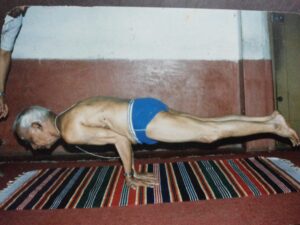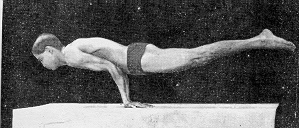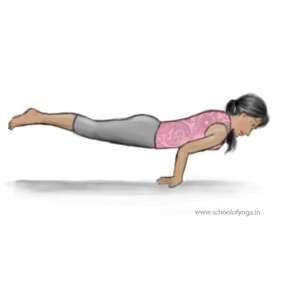What is mayurāsana (peacock pose)?

Mayurāsana or peacock Pose is an āsana where the entire body is held straight horizontally by balancing it on the hands and with elbows against the abdomen. Mayurāsana is an advanced āsanawhich must be learned under instruction with an advanced yoga expert.
How does one practice mayurāsana? (should be learned under supervision)
- Sthithi (starting) position: First, kneel on the ground.
- Second, bring the forearms together such that the little fingers of both hands are touching.
- Third, plant palm firmly on ground near knees with fingers facing the knee and inside of the forearm facing out.
- Now, inhale partially and stiffen abdominal muscles.
- Following this, let abdomen fall gently on the back of the joined elbows such that elbows are in the region of the navel. Do not relax abdominal muscles.
- Slowly, stretch legs back one at a time and stiffen them.
- Retaining the breath, rock body forward slightly such that legs lift, body is balanced evenly on hands and parallel to the ground.
- Importantly, the legs should remain straight as well as stretched and buttocks contracted.
- Retain for 5 counts.
- Slowly, come back to sthithi position.
- The dṛṣṭi (gaze) recommended is maṇipūra-cakra
What are the benefits of practicing mayurāsana?
-

Yogacharya Sundaram demonstrating mayurāsana @25 First, when this exercise is performed, organs within the abdominal cavity are placed under pressure. Therefore, there is increased intra-abdominal pressure which induces peristalsis. As a result, there is very good evacuation of the bowels.
- Additionally, the intra-abdominal massage also ensures good blood supply to all muscles within the abdomen ensuring optimum functioning.
- Mayurāsana is very good for removing flatulence, constipation and piles.
- Also, this exercise also improves functioning of liver, pancreas and kidneys, thus removing digestive ailments.
- Mayurāsana is also very good for ensuring better abdominal inter-organ orientation.
- Finally, the action of lifting legs and balancing body on the wrists strengthens muscles of the wrist, forearms and lower back.
- Lastly, this āsana is good for stabilising irregularities in periods for women.
What are the mayurāsana contraindications?
 First, if you have any form of back ache, do not attempt this āsana without adequate expert supervision and support.
First, if you have any form of back ache, do not attempt this āsana without adequate expert supervision and support.- Importantly, this āsana should not to be done by people having neck ailments or lower back ailments like cervical or lumbar spondylitis.
- Also, those with cardiac problems such as high blood pressure should start this exercise only after getting proficiency in other āsana and that too, increase intensity of practice gradually, under guidance of a doctor.
- Additionally, people with kidney or liver ailments, hernia etc should avoid this āsana.
- Finally, practitioners suffering from wrist problems like carpal tunnel will find this exercise difficult to perform. There will be severe pain at the wrist. Hence, one should first perform wrist movement and strengthening exercises before slowly increasing load on the wrists. If the pain continues, stop.
- Lastly, this āsana should not be practiced during menstruation and pregnancy.
Mayurāsana according to Hatha Yoga Pradeepika
Chapter 1 v (30) mayurāsana – Placing both hands on the ground, rest the navel on the elbows and balancing thus, raise the body in the air like a rod. This position is called mayura.
Chapter 1 v (31) mayura cures all diseases like gulma (enlargement of glands in the abdomen like spleen), udara (stomach), removes irregularities arising from imbalance of phlegm, bile and wind. It enables digestion of food taken in excess and restores appetite, even having ability to digest poison.
Some noteworthy points on mayurāsana
Internal Links: Dharma (conditioning), Stress and Situational Awareness, Prana, Asana sequence, Asana schedule, Asana Focus or gazing, Pranayama, Hatha Yoga Pradeepika
External Links: Prana, Chakra, Pancha Tattva, Pancha Prana, Pancha Kosha, Nadi,
- Importantly, since there is a danger of toppling, when there is imbalance, fall to the side so as not to fall and injure your face.
- Additionally, it is advisable to keep a soft pillow in front to prevent damage to the face. If falling sideways, use the deltoids to break the fall.
- Also, one of the problems in performing this āsana is maintaining both, axial (along the length of the body) and lateral (balance between hands) balance. Keep hands slightly apart such that the elbows sit on either side of the abdominal muscle (abs). This increases lateral balance.
- If you do not feel confident about maintaining balance along the length of your body, you can get similar benefits by practicing a variation of this āsana. This is called hamsāsana (swan pose) and is performed without lifting the off the ground. Later, as confidence increases, one could first lift one foot and then the other.
- Lastly, the reason one is asked to take a half breath as in śalabhāsana is to ensure that the abdomen is not unduly stressed. In complete exhalation, the abdominal viscera would be loosely packed in the abdomen, while after complete inhalation; the abdomen would be tight, leading to stomach cramps. This is avoided by taking a half breath whereby the abdomen is not stressed.
